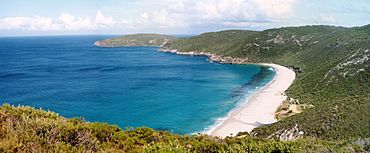West Cape Howe National Park facts for kids
Quick facts for kids West Cape Howe National ParkWestern Australia |
|
|---|---|
|
IUCN Category II (National Park)
|
|

View across Shelley Beach to West Cape Howe
|
|
| Nearest town or city | Denmark |
| Established | 1985 |
| Area | 36.05 km2 (13.9 sq mi) |
| Managing authorities | Department of Parks and Wildlife |
| Website | West Cape Howe National Park |
| See also | List of protected areas of Western Australia |
West Cape Howe National Park is a special protected area in Western Australia. It's about 390 kilometers (242 miles) southeast of Perth. You can find this park between the towns of Albany and Denmark. It's part of the Great Southern region.
Inside the park is Torbay Head, which is the most southerly point of mainland Western Australia. The park stretches along the coast of the Southern Ocean for about 23 kilometers (14 miles). This coastline runs between Lowlands Beach and Forsythe Bluff.
How West Cape Howe National Park Started
West Cape Howe National Park has an interesting history. It wasn't always a national park.
From Recreation Area to Park
The area first became a protected spot in 1977. At that time, the local government, the Shire of Albany, looked after it for people to use for fun activities. By 1985, it was officially named a "C Class Reserve." This happened after the Shire of Albany agreed with the National Parks and Nature Conservancy Authority.
Becoming an "A Class" Park
In 1987, the park became even more important. An extra 41 hectares (101 acres) of land, which used to be a timber reserve, was added to its northern edge. This made the park an "A Class" reserve. Today, West Cape Howe National Park is a single reserve that covers about 3,517 hectares (8,691 acres).
Amazing Plants and Animals
West Cape Howe National Park is home to many different kinds of plants and animals. It has various natural areas, called habitats.
Diverse Habitats and Rare Plants
The park includes tall karri forests, open coastal heathlands, and wet wetlands. Each of these places supports a wide variety of plants. Around Lake William, you can find thick sedge plants. Some very rare plants also grow here, like Amperea volubilus and a special type of Melaleuca that hasn't been officially named yet. You might also spot the unique Albany Pitcher Plant, known as Cephalotus follicularis, which is a carnivorous plant.
Discovering Rare Spiders
In 2008, scientists did a survey in the park. They found a very rare and old spider called the Main's assassin spider. This spider is currently listed as a threatened species, meaning it's at risk of disappearing.
Things to Do and See
West Cape Howe National Park offers many activities for visitors.
Exploring by Vehicle
Many of the park's tracks are very sandy. This means that most of the park can only be reached by four-wheel drive vehicles. However, all types of vehicles can get to the popular Shelley Beach.
Shelley Beach Fun
Shelley Beach is a great spot to visit. It has a campground where you can stay overnight. There's also a look-out point where you can enjoy amazing views. You'll find toilets and barbecue facilities there too. For those who love adventure, Shelley Beach is a popular place for hang-gliders to launch into the sky.
Surfing at Golden Gate Beach
Close by, Golden Gate Beach is a favorite spot for surfers. The waves here are perfect for riding!
Walking and Hiking Trails
The famous Bibbulmun Track, a long-distance walking trail in Western Australia, goes right through West Cape Howe National Park.
Trails and Shelters for Hikers
The park has many facilities for people who enjoy bushwalking. There's a 15-kilometer (9.3-mile) return trail that branches off the main Bibbulmun Track and leads to Torbay Head. Part of the Bibbulmun Track in the park also has a boardwalk, making it easier to walk. In the western part of the park, there's a special overnight shelter for walkers. It's called "West Cape Howe Campsite" and can sleep 12 to 15 people.


